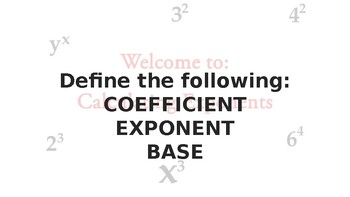INDICES LESSON
syeblues education
2 Followers
Resource Type
Standards
CCSSHSN-Q.A.2
CCSSHSN-Q.A.3
CCSSMP1
Formats Included
- PPTX
Pages
22 pages
syeblues education
2 Followers
Description
This power-point lesson introduces the concept of indices. The lesson has the following outcomes simplifying by using multiplication, raising powers correctly
and dividing indices.
Various activities and questions are included at differing ability levels.
All answers are included.
Total Pages
22 pages
Answer Key
Included
Teaching Duration
90 minutes
Last updated 6 months ago
Report this resource to TPT
Reported resources will be reviewed by our team. Report this resource to let us know if this resource violates TPT’s content guidelines.
Standards
to see state-specific standards (only available in the US).
CCSSHSN-Q.A.2
Define appropriate quantities for the purpose of descriptive modeling.
CCSSHSN-Q.A.3
Choose a level of accuracy appropriate to limitations on measurement when reporting quantities.
CCSSMP1
Make sense of problems and persevere in solving them. Mathematically proficient students start by explaining to themselves the meaning of a problem and looking for entry points to its solution. They analyze givens, constraints, relationships, and goals. They make conjectures about the form and meaning of the solution and plan a solution pathway rather than simply jumping into a solution attempt. They consider analogous problems, and try special cases and simpler forms of the original problem in order to gain insight into its solution. They monitor and evaluate their progress and change course if necessary. Older students might, depending on the context of the problem, transform algebraic expressions or change the viewing window on their graphing calculator to get the information they need. Mathematically proficient students can explain correspondences between equations, verbal descriptions, tables, and graphs or draw diagrams of important features and relationships, graph data, and search for regularity or trends. Younger students might rely on using concrete objects or pictures to help conceptualize and solve a problem. Mathematically proficient students check their answers to problems using a different method, and they continually ask themselves, "Does this make sense?" They can understand the approaches of others to solving complex problems and identify correspondences between different approaches.





